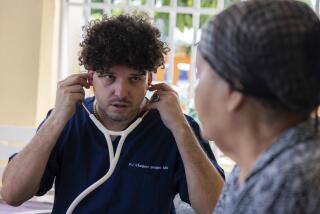Clinic Is a Town’s Lifeblood : Health: The center in Val Verde closed two years ago, but it reopened and is busier than ever. Most of its patients lack insurance and pay according to income.
- Share via
New mother Betty Rivas can’t imagine juggling school, work and her baby daughter without the Samuel Dixon Family Health Center in Val Verde.
The 16-year-old has no car and little money. If the clinic were to close, she and 2-month-old Vanessa would have to travel 25 miles by bus to the county-operated Olive View-UCLA Medical Center in Sylmar to receive medical care. Her job and her classes at Saugus High School would be disrupted every time her baby needed a checkup or a shot.
For now, Rivas doesn’t have to worry. The clinic in Val Verde, an isolated community southwest of Castaic near the Ventura County line, closed for six months after its funding ran out two years ago. But it reopened in early 1991 and is now busier than ever.
“We really need this here,” said Rivas as she waited in line at the clinic Saturday to get her daughter inoculated. “When I was little, my parents brought me here. I got my first pregnancy test here and now I take my daughter here.”
The 1,600 residents of the town, founded as a resort for middle-class black families but now with a growing Latino population, can walk to the clinic to seek routine medical advice and treatment. They pay for services on a sliding scale based on their incomes.
Rivas’ comments came as she clutched daughter Vanessa to her chest with one hand and held a batch of health literature with the other. She was among about 150 people who stopped by a Kids Care Fair at the center Saturday.
The fair offered parents and children free tests for blood pressure, vision and hearing. Children were given comic books that discourage smoking, as well as coloring books and balloons with messages encouraging good health practices.
The fair also celebrated the center’s recent fund-raising triumph, its second $120,000 federal Community Development Block Grant in two years.
The clinic--named for a local pastor and civic leader who helped found it in 1980--had to close in August, 1990, when Santa Monica Hospital, its sponsor, withdrew a $68,000 annual grant for rural physician services.
“We had to pick ourselves up by our bootstraps,” said Edwin Seth Brown, president of the clinic’s board of directors. Brown helped found the clinic and he led the campaign to resurrect it.
Brown and other Val Verde leaders recast the clinic as a nonprofit corporation, qualifying it for government grants and a county license allowing it to operate independently. Then they got the federal money through the Los Angeles County Board of Supervisors and $26,000 from the United Way.
Today, the clinic is growing rapidly. About 850 people received medical treatment there last year and already this year 1,000 patients have passed through its doors.
About 63% of the clinic’s patients come from families with annual incomes of less than $10,000, and most have no health insurance. They are treated for such afflictions as colds, fevers and sinus and upper respiratory infections.
Still, the clinic can afford to offer most of its services only three days a week, which barely keeps up with the demand, said Executive Director Peggy J. Freeman. She hopes to raise more funds from private donations to expand services.
In addition to the medical services it offers, the clinic sponsors computer and literacy skills training, and classes in AIDS awareness and family planning.
For Marta Rico, a 27-year-old single parent who supports two children with a job at a McDonald’s in Castaic, the clinic is part of the acculturation process. She has lived in either Val Verde or Castaic since arriving in the United States nine years ago, and the clinic has provided her with a variety of services.
“I’m learning so many things,” Rico said. “This is where I get all my information about health. It would be terrible if it shut down.”
Freeman said she finds her job as the head of the health clinic fulfilling. As a child, her parents and her four siblings had to rely on welfare payments because her father became disabled.
“I was raised on welfare, and going to clinics was dehumanizing,” she said. “That experience is what draws me here, to do it differently.”
More to Read
Sign up for Essential California
The most important California stories and recommendations in your inbox every morning.
You may occasionally receive promotional content from the Los Angeles Times.










